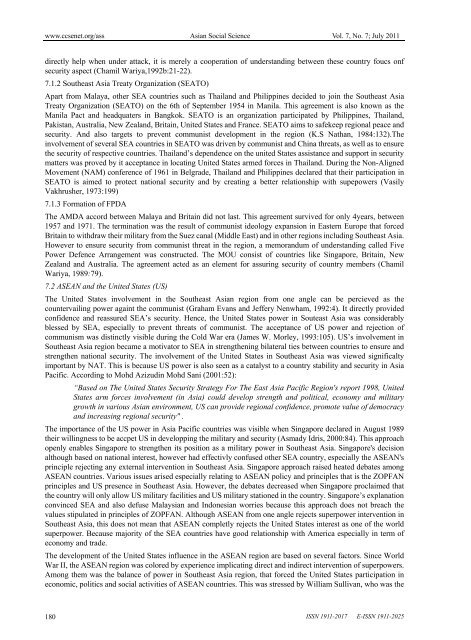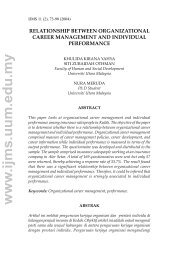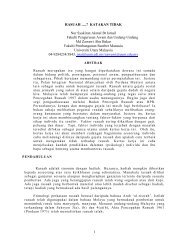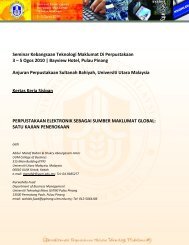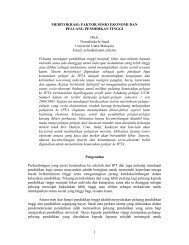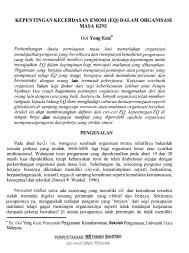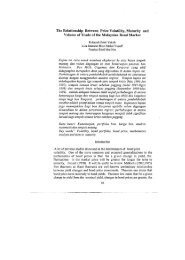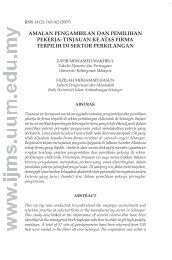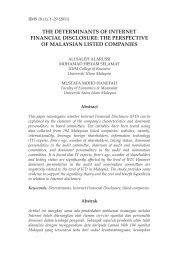The Development of ASEAN from Historical Approach
The Development of ASEAN from Historical Approach
The Development of ASEAN from Historical Approach
You also want an ePaper? Increase the reach of your titles
YUMPU automatically turns print PDFs into web optimized ePapers that Google loves.
www.ccsenet.org/ass Asian Social Science Vol. 7, No. 7; July 2011<br />
directly help when under attack, it is merely a cooperation <strong>of</strong> understanding between these country foucs onf<br />
security aspect (Chamil Wariya,1992b:21-22).<br />
7.1.2 Southeast Asia Treaty Organization (SEATO)<br />
Apart <strong>from</strong> Malaya, other SEA countries such as Thailand and Philippines decided to join the Southeast Asia<br />
Treaty Organization (SEATO) on the 6th <strong>of</strong> September 1954 in Manila. This agreement is also known as the<br />
Manila Pact and headquaters in Bangkok. SEATO is an organization participated by Philippines, Thailand,<br />
Pakistan, Australia, New Zealand, Britain, United States and France. SEATO aims to safekeep regional peace and<br />
security. And also targets to prevent communist development in the region (K.S Nathan, 1984:132).<strong>The</strong><br />
involvement <strong>of</strong> several SEA countries in SEATO was driven by communist and China threats, as well as to ensure<br />
the security <strong>of</strong> respective countries. Thailand’s dependence on the united States assistance and support in security<br />
matters was proved by it acceptance in locating United States armed forces in Thailand. During the Non-Aligned<br />
Movement (NAM) conference <strong>of</strong> 1961 in Belgrade, Thailand and Philippines declared that their participation in<br />
SEATO is aimed to protect national security and by creating a better relationship with supepowers (Vasily<br />
Vakhrusher, 1973:199)<br />
7.1.3 Formation <strong>of</strong> FPDA<br />
<strong>The</strong> AMDA accord between Malaya and Britain did not last. This agreement survived for only 4years, between<br />
1957 and 1971. <strong>The</strong> termination was the result <strong>of</strong> communist ideology expansion in Eastern Europe that forced<br />
Britain to withdraw their military <strong>from</strong> the Suez canal (Middle East) and in other regions including Southeast Asia.<br />
However to ensure security <strong>from</strong> communist threat in the region, a memorandum <strong>of</strong> understanding called Five<br />
Power Defence Arrangement was constructed. <strong>The</strong> MOU consist <strong>of</strong> countries like Singapore, Britain, New<br />
Zealand and Australia. <strong>The</strong> agreement acted as an element for assuring security <strong>of</strong> country members (Chamil<br />
Wariya, 1989:79).<br />
7.2 <strong>ASEAN</strong> and the United States (US)<br />
<strong>The</strong> United States involvement in the Southeast Asian region <strong>from</strong> one angle can be percieved as the<br />
countervailing power againt the communist (Graham Evans and Jeffery Nenwham, 1992:4). It directly provided<br />
confidence and reassured SEA’s security. Hence, the United States power in Souteast Asia was considerably<br />
blessed by SEA, especially to prevent threats <strong>of</strong> communist. <strong>The</strong> acceptance <strong>of</strong> US power and rejection <strong>of</strong><br />
communism was distinctly visible during the Cold War era (James W. Morley, 1993:105). US’s involvement in<br />
Southeast Asia region became a motivator to SEA in strengthening bilateral ties between countries to ensure and<br />
strengthen national security. <strong>The</strong> involvement <strong>of</strong> the United States in Southeast Asia was viewed significalty<br />
important by NAT. This is because US power is also seen as a catalyst to a country stability and security in Asia<br />
Pacific. According to Mohd Azizudin Mohd Sani (2001:52):<br />
“Based on <strong>The</strong> United States Security Strategy For <strong>The</strong> East Asia Pacific Region's report 1998, United<br />
States arm forces involvement (in Asia) could develop strength and political, economy and military<br />
growth in various Asian environment, US can provide regional confidence, promote value <strong>of</strong> democracy<br />
and increasing regional security" .<br />
<strong>The</strong> importance <strong>of</strong> the US power in Asia Pacific countries was visible when Singapore declared in August 1989<br />
their willingness to be accpet US in developping the military and security (Asmady Idris, 2000:84). This approach<br />
openly enables Singapore to strengthen its position as a military power in Southeast Asia. Singapore's decision<br />
although based on national interest, however had effectivly confused other SEA country, especially the <strong>ASEAN</strong>'s<br />
principle rejecting any external intervention in Southeast Asia. Singapore approach raised heated debates among<br />
<strong>ASEAN</strong> countries. Various issues arised especially relating to <strong>ASEAN</strong> policy and principles that is the ZOPFAN<br />
principles and US presence in Southeast Asia. However, the debates decreased when Singapore proclaimed that<br />
the country will only allow US military facilities and US military stationed in the country. Singapore’s explanation<br />
convinced SEA and also defuse Malaysian and Indonesian worries because this approach does not breach the<br />
values stipulated in principles <strong>of</strong> ZOPFAN. Although <strong>ASEAN</strong> <strong>from</strong> one angle rejects superpower intervention in<br />
Southeast Asia, this does not mean that <strong>ASEAN</strong> completly rejects the United States interest as one <strong>of</strong> the world<br />
superpower. Because majority <strong>of</strong> the SEA countries have good relationship with America especially in term <strong>of</strong><br />
economy and trade.<br />
<strong>The</strong> development <strong>of</strong> the United States influence in the <strong>ASEAN</strong> region are based on several factors. Since World<br />
War II, the <strong>ASEAN</strong> region was colored by experience implicating direct and indirect intervention <strong>of</strong> superpowers.<br />
Among them was the balance <strong>of</strong> power in Southeast Asia region, that forced the United States participation in<br />
economic, politics and social activities <strong>of</strong> <strong>ASEAN</strong> countries. This was stressed by William Sullivan, who was the<br />
180<br />
ISSN 1911-2017 E-ISSN 1911-2025


